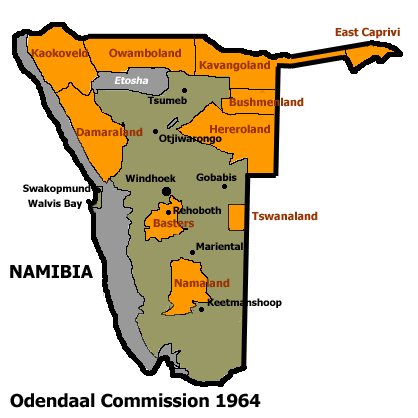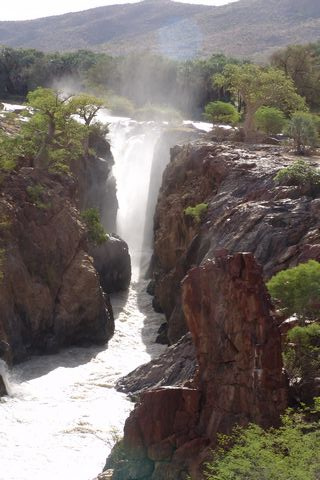|
Calueque Dam
The Caluequee Dam, is an operational multipurpose dam across the Kunene River, in Kunene Province, in southwestern Angola. The dam stores water for the Ruacana Hydroelectric Power Station, in neighboring Namibia. Its waters are also used for the irrigation of farmland, both in Angola and Namibia. Location The dam is located in the town of Calueque, close to the international border with Namibia, approximately , by road, southwest of the town of Ondjiva, the provincial capital. The dam is approximately , by road, south of Luanda, the capital city of Angola. The geographical coordinates of Calueque Dam are 17°16'22.0"S, 14°32'40.0"E (Latitude:-17.272778; Longitude:14.544444). History In October 1964, representatives of the government of Portugal and the government of South Africa met in Lisbon, Portugal and signed agreements relating to the construction of dams on the Kunene River, thereby controlling the rate of flow of the river and maximizing electricity output at the d ... [...More Info...] [...Related Items...] OR: [Wikipedia] [Google] [Baidu] |
Angola
, national_anthem = " Angola Avante"() , image_map = , map_caption = , capital = Luanda , religion = , religion_year = 2020 , religion_ref = , coordinates = , largest_city = capital , official_languages = Portuguese , languages2_type = National languages , languages2 = , ethnic_groups = , ethnic_groups_ref = , ethnic_groups_year = 2000 , demonym = , government_type = Unitary dominant-party presidential republic , leader_title1 = President , leader_name1 = João Lourenço , leader_title2 = Vice President , leader_name2 = Esperança da CostaInvestidura do Pr ... [...More Info...] [...Related Items...] OR: [Wikipedia] [Google] [Baidu] |
South West Africa
South West Africa ( af, Suidwes-Afrika; german: Südwestafrika; nl, Zuidwest-Afrika) was a territory under South African administration from 1915 to 1990, after which it became modern-day Namibia. It bordered Angola (Portuguese colony before 1975), Botswana ( Bechuanaland before 1966), South Africa, and Zambia (Northern Rhodesia before 1964). Previously the German colony of South West Africa from 1884–1915, it was made a League of Nations mandate of the Union of South Africa following Germany's defeat in the First World War. Although the mandate was abolished by the United Nations in 1966, South African control over the territory continued despite its illegality under international law. The territory was administered directly by the South African government from 1915 to 1978, when the Turnhalle Constitutional Conference laid the groundwork for semi-autonomous rule. During an interim period between 1978 and 1985, South Africa gradually granted South West Africa a limited for ... [...More Info...] [...Related Items...] OR: [Wikipedia] [Google] [Baidu] |
Dams In Angola
A dam is a barrier that stops or restricts the flow of surface water or underground streams. Reservoirs created by dams not only suppress floods but also provide water for activities such as irrigation, human consumption, industrial use, aquaculture, and navigability. Hydropower is often used in conjunction with dams to generate electricity. A dam can also be used to collect or store water which can be evenly distributed between locations. Dams generally serve the primary purpose of retaining water, while other structures such as floodgates or levees (also known as dikes) are used to manage or prevent water flow into specific land regions. The earliest known dam is the Jawa Dam in Jordan, dating to 3,000 BC. The word ''dam'' can be traced back to Middle English, and before that, from Middle Dutch, as seen in the names of many old cities, such as Amsterdam and Rotterdam. History Ancient dams Early dam building took place in Mesopotamia and the Middle East. Dams were used ... [...More Info...] [...Related Items...] OR: [Wikipedia] [Google] [Baidu] |
Energy In Angola
Energy in Angola describes energy and electricity production, consumption and export from Angola. The energy policy of Angola reflects energy policy and the politics of Angola. Biomass accounts for 58% of the country's energy consumption; oil accounts for 35%, gas 4% and hydroelectric power 3%. Primary energy use in 2009 in Angola was 138 TWh and 7 TWh per million persons.IEA Key energy statistics 2011 Page: Country specific indicator numbers from page 48 Angolans use to suffer frequent daily blackouts. In 2012, days before the election, the government announced $17B US in planned energy investment, designed to alleviate the paucity of available energy. Overview [...More Info...] [...Related Items...] OR: [Wikipedia] [Google] [Baidu] |
Oshakati
Oshakati is a town in northern Namibia. It is the regional capital of the Oshana Region and one of Namibia's largest places. Oshakati was founded in July 1966 and proclaimed a town in 1992. The town was used as a base of operations by the South African Defence Force (SADF) during the South African Border War. History In Oshiwambo, the language of the Ovambo people, the town's name means "that which is in between", although some believe that the name (Oshakati, also Otshakati) was used to refer to the broadcasting tower ( high), the tallest structure in the town centre and in Namibia. On 19 February 1988, a bomb blast occurred in Oshakati at the First National Bank, killing 27 people and badly injuring nearly 30 others, most of them nurses and teachers. No one was ever convicted of the bombing and the issue was dropped upon independence in 1990 in favour of national reconciliation. Economy and infrastructure Oshakati has experienced much development since Namibia achie ... [...More Info...] [...Related Items...] OR: [Wikipedia] [Google] [Baidu] |
The New York Times
''The New York Times'' (''the Times'', ''NYT'', or the Gray Lady) is a daily newspaper based in New York City with a worldwide readership reported in 2020 to comprise a declining 840,000 paid print subscribers, and a growing 6 million paid digital subscribers. It also is a producer of popular podcasts such as '' The Daily''. Founded in 1851 by Henry Jarvis Raymond and George Jones, it was initially published by Raymond, Jones & Company. The ''Times'' has won 132 Pulitzer Prizes, the most of any newspaper, and has long been regarded as a national " newspaper of record". For print it is ranked 18th in the world by circulation and 3rd in the U.S. The paper is owned by the New York Times Company, which is publicly traded. It has been governed by the Sulzberger family since 1896, through a dual-class share structure after its shares became publicly traded. A. G. Sulzberger, the paper's publisher and the company's chairman, is the fifth generation of the family to head the pa ... [...More Info...] [...Related Items...] OR: [Wikipedia] [Google] [Baidu] |
Angolan Civil War
The Angolan Civil War ( pt, Guerra Civil Angolana) was a civil war in Angola, beginning in 1975 and continuing, with interludes, until 2002. The war immediately began after Angola became independent from Portugal in November 1975. The war was a power struggle between two former anti-colonial guerrilla movements, the communist People's Movement for the Liberation of Angola (MPLA) and the turned anti-communist National Union for the Total Independence of Angola (UNITA). The war was used as a surrogate battleground for the Cold War by rival states such as the Soviet Union, Cuba, South Africa, and the United States. The MPLA and UNITA had different roots in Angolan society and mutually incompatible leaderships, despite their shared aim of ending colonial rule. A third movement, the National Front for the Liberation of Angola (FNLA), having fought the MPLA with UNITA during the war for independence, played almost no role in the Civil War. Additionally, the Front for the Liberati ... [...More Info...] [...Related Items...] OR: [Wikipedia] [Google] [Baidu] |
Food And Agriculture Organization
The Food and Agriculture Organization of the United Nations (FAO)french: link=no, Organisation des Nations unies pour l'alimentation et l'agriculture; it, Organizzazione delle Nazioni Unite per l'Alimentazione e l'Agricoltura is an international organization that leads international efforts to defeat hunger and improve nutrition and food security. Its Latin motto, ', translates to "let there be bread". It was founded on 16 October 1945. The FAO is composed of 195 members (including 194 countries and the European Union). Their headquarters is in Rome, Italy, and the FAO maintains regional and field offices around the world, operating in over 130 countries. It helps governments and development agencies coordinate their activities to improve and develop agriculture, forestry, fisheries, and land and water resources. It also conducts research, provides technical assistance to projects, operates educational and training programs, and collects data on agricultural output, produ ... [...More Info...] [...Related Items...] OR: [Wikipedia] [Google] [Baidu] |
Gove Dam
The Gove Dam is an embankment dam on the Kunene River about south of Huambo in Huambo Province, Angola. The purpose of the dam is to control floods and generate hydroelectric power. It has a power generating capacity of each) (three turbines of each), enough to power over 30,000 homes. History The Gove Dam cost US$279 million and was built by Brazilian construction group Odebrecht. It was formally inaugurated in August 2012 by the Angolan President. The dam produces power for the cities of Caála, Huambo, and Kuito. Construction of the dam began in 1969 and it was completed in 1975. Construction of the power station was halted twice, from 1975 to 1983 due to the civil war, then again from 1986 to 2001 also due to fighting. The dam was partially destroyed by dynamite in 1990. Along with the power station, sub-stations at Caála, Dango, and Benfica (in Huambo) were inaugurated at the time of completion. The sub-stations and distribution network cost US$80 million. See also ... [...More Info...] [...Related Items...] OR: [Wikipedia] [Google] [Baidu] |
Lisbon, Portugal
Lisbon (; pt, Lisboa ) is the capital and largest city of Portugal, with an estimated population of 544,851 within its administrative limits in an area of 100.05 km2. Lisbon's urban area extends beyond the city's administrative limits with a population of around 2.7 million people, being the 11th-most populous urban area in the European Union.Demographia: World Urban Areas - demographia.com, 06.2021 About 3 million people live in the , making it the third largest metropolitan area in the , aft ... [...More Info...] [...Related Items...] OR: [Wikipedia] [Google] [Baidu] |
Kunene River
The Cunene (Portuguese spelling) or Kunene (common Namibian spelling) is a river in Southern Africa. It flows from the Angola highlands south to the border with Namibia. It then flows west along the border until it reaches the Atlantic Ocean. It is one of the few perennial rivers in the region. It is about long, with a drainage basin in area. Its mean annual discharge is 174 m3/s (6,145 cfs) at its mouth. The Epupa Falls lie on the river. Olushandja Dam dams a tributary of the river, the Etaka, and helps provide the Ruacana Power Station with water. Dam controversies The Namibian government proposed in the late 1990s to build the Epupa Dam, a controversial hydroelectric dam on the Cunene. In 2012 the Governments of Namibia and Angola announced plans to jointly build the Orokawe dam in the Baynes Mountains. According to the indigenous Himba who would have been most affected by the construction of the dam, the dam threatens the local ecosystem and therefore the economic bas ... [...More Info...] [...Related Items...] OR: [Wikipedia] [Google] [Baidu] |



.png)


